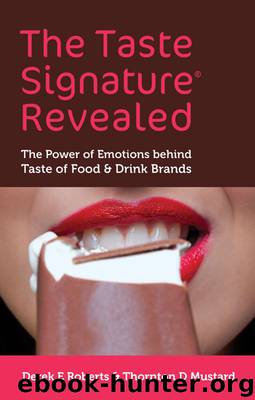The Taste Signature® Revealed by Derek E. Roberts & Thornton D. Mustard

Author:Derek E. Roberts & Thornton D. Mustard
Language: eng
Format: epub
ISBN: 9781907722912
Publisher: The Taste Signature® Revealed
Chapter Twelve
Moreishness, Drinkability, Refreshment and Satiation
Summary
• Moreishness is defined as the response of wanting more of a product
• Taste intensity has a major role in avoiding the opposite of Moreishness - Satiation
• Chips are a classic example of a moreish product having a short duration of taste and drying the mouth
• The equivalent of Moreishness in drinks is Drinkability and Sessionability
• These both require that the drink has some stimulation but that it returns the mouth to its original state
• Both Moreishness and Drinkability are heavily influenced by even small changes in the Journey of Taste
• Refreshment on the other hand is all about liveliness and stimulating the taste buds
• Satiation is derived from high taste stimulation which lingers in the aftertaste
Moreishness is defined as a response to the food or drink that, once swallowed, encourages the consumer or even drives them to want to consume more of the same product. It is not when the consumption of one product creates the demand for another item to cause an in-mouth balance – for example salty snacks with beer. It is motivated to have more of the same and is very individually food-specific as it manifests in different ways in different foods.
It is derived from the nature of the swallowing of a food, a reflex action that is largely involuntary. At the point where the food item has been sufficiently chewed and received the full benefit of the in-mouth enzymes, it requires a specific act of will not to swallow. As a result, the consumer now misses the product’s enjoyment and needs it to be continued. The key is that the food’s taste delivery needs to be lost following the swallow or it will not be missed by the consumer. A strong lingering aftertaste is unlikely to be moreish. This is linked to the arrival in the stomach and the reaction to food that, for example, may be substantial in protein, fat or carbohydrate content or spiciness. Subconsciously this is linked to the taste hit and aftertaste to decide how much has been consumed. If the message is ‘not much’ then permission is given to keep eating – hence blandness, to a certain extent, works.
Taste intensity is very important because as the intensity builds up in the mouth, so do the feelings of having eaten enough start to emerge and the consumer feels full. As this begins to happen so Moreishness goes into reverse and the feeling of satiation begins prompting the consumer to consider stopping eating the particular product. They are too full or uncomfortable but this is very subjective and based on learnt experience and by the individual’s value structure which causes them to say ‘I do not like to feel like this.’ Therefore, very strong tastes can fool the stomach into thinking they have eaten more than they believe; spicy ethnic foods or Marmite/Vegemite are classic examples. Conversely, sweet candy is generally the opposite as sweetness on its own tends not to provide satiation. Therefore, it is possible to continue to consume even though there is a lot of sugar sweetness in the stomach.
Download
This site does not store any files on its server. We only index and link to content provided by other sites. Please contact the content providers to delete copyright contents if any and email us, we'll remove relevant links or contents immediately.
Life 3.0: Being Human in the Age of Artificial Intelligence by Tegmark Max(5356)
The Sports Rules Book by Human Kinetics(4180)
The Age of Surveillance Capitalism by Shoshana Zuboff(4094)
ACT Math For Dummies by Zegarelli Mark(3915)
Unlabel: Selling You Without Selling Out by Marc Ecko(3534)
Blood, Sweat, and Pixels by Jason Schreier(3524)
Hidden Persuasion: 33 psychological influence techniques in advertising by Marc Andrews & Matthijs van Leeuwen & Rick van Baaren(3389)
The Pixar Touch by David A. Price(3306)
Urban Outlaw by Magnus Walker(3287)
Bad Pharma by Ben Goldacre(3183)
Project Animal Farm: An Accidental Journey into the Secret World of Farming and the Truth About Our Food by Sonia Faruqi(3119)
Kitchen confidential by Anthony Bourdain(2948)
Brotopia by Emily Chang(2932)
Slugfest by Reed Tucker(2870)
The Content Trap by Bharat Anand(2818)
The Airbnb Story by Leigh Gallagher(2739)
Coffee for One by KJ Fallon(2503)
Smuggler's Cove: Exotic Cocktails, Rum, and the Cult of Tiki by Martin Cate & Rebecca Cate(2411)
Beer is proof God loves us by Charles W. Bamforth(2328)
